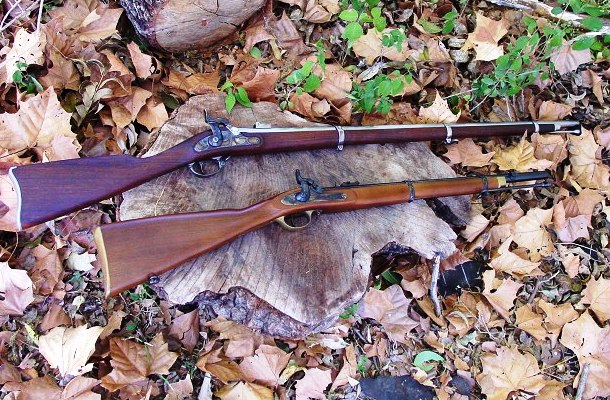Pattern 1861 Enfield Musketoon on:
[Wikipedia]
[Google]
[Amazon]

 The Pattern 1861 Enfield
The Pattern 1861 Enfield

 The Pattern 1861 Enfield
The Pattern 1861 Enfield musketoon
The musketoon is a shorter-barrelled version of the musket and served in the roles of a shotgun or carbine. Musketoons could be of the same caliber as the issue musket or of a much larger caliber, 1.0–2.5 inches (25–63 mm). The musketoon ...
was a short-barrel version (610 mm or 24 inches) of the Pattern 1853 Enfield
The Enfield Pattern 1853 rifle-musket (also known as the Pattern 1853 Enfield, P53 Enfield, and Enfield rifle-musket) was a .577 calibre Minié-type muzzle-loading rifled musket, used by the British Empire from 1853 to 1867; after which many wer ...
rifled musket, having a faster rifling twist rate (1:48 versus 1:78), along with more rifling grooves (five grooves versus the Pattern 1853's three grooves), which made it as accurate as the rifle at shorter ranges. The much shorter barrel would otherwise reduce the accuracy at longer ranges. The shorter rifle was therefore easier to carry and reload.
Usage
In theBritish Army
The British Army is the principal land warfare force of the United Kingdom, a part of the British Armed Forces along with the Royal Navy and the Royal Air Force. , the British Army comprises 79,380 regular full-time personnel, 4,090 Gurk ...
, the Pattern 1861 was issued to artillery
Artillery is a class of heavy military ranged weapons that launch munitions far beyond the range and power of infantry firearms. Early artillery development focused on the ability to breach defensive walls and fortifications during siege ...
units, who required a weapon for personal defence and which could be more easily wielded from horseback. They were also imported by the Confederacy during the American Civil War
The American Civil War (April 12, 1861 – May 26, 1865; also known by other names) was a civil war in the United States. It was fought between the Union ("the North") and the Confederacy ("the South"), the latter formed by states ...
and issued to artillery and cavalry units. However, the longer Pattern 1853 was more suitable for infantry
Infantry is a military specialization which engages in ground combat on foot. Infantry generally consists of light infantry, mountain infantry, motorized infantry & mechanized infantry, airborne infantry, air assault infantry, and mar ...
units which fought in line formation
The line formation is a standard tactical formation which was used in early modern warfare.
It continued the phalanx formation or shield wall of infantry armed with polearms in use during antiquity and the Middle Ages.
The line formation provi ...
of several ranks deep, in order to minimize the risk that the men in the rear ranks would accidentally shoot the men in the front ranks in the back of the head, or scorch their faces and burst their eardrums with the muzzle blast.
It was much liked for its ease of handling, and being designed for use with Minié ball
The Minié ball or Minie ball, is a type of hollow-based bullet designed by Claude-Étienne Minié, inventor of the French Minié rifle, for muzzle-loading rifled muskets. It was invented in 1847 and came to prominence in the Crimean War and ...
bullets they could have a lethal range of up to 500 yards.
This weapon is often referred to as a musketoon but due to it having a rifled barrel is more accurately known as a carbine. Note that Enfield Pattern 58 'short rifle' is almost a foot 0cmslonger. This mistake is prevalent in the popular literature probably due to the misnomer being applied to a Parker Hale
Parker-Hale Ltd. was a British firearms, air rifle and firearms accessory manufacturer, located in the Gun Quarter of the city of Birmingham, England. It was founded by Alfred Gray Parker and Arthur Hale.
History
Alfred Gray Parker founded a ri ...
reproduction.
See also
*Pattern 1853 Enfield
The Enfield Pattern 1853 rifle-musket (also known as the Pattern 1853 Enfield, P53 Enfield, and Enfield rifle-musket) was a .577 calibre Minié-type muzzle-loading rifled musket, used by the British Empire from 1853 to 1867; after which many wer ...
, a longer rifle musket of very similar design.
* British military rifles
The origins of the modern British military rifle are within its predecessor the Brown Bess musket. While a musket was largely inaccurate over , due to a lack of rifling and a generous tolerance to allow for muzzle-loading, it was cheap to prod ...
* Rifles in the American Civil War
During the American Civil War, an assortment of small arms found their way onto the battlefield. Though the muzzleloader percussion cap rifle was the most numerous weapon, being standard issue for the Union and Confederate armies, many other f ...
References
External links
American Civil War rifles Weapons of the Confederate States of America Victorian-era weapons of the United Kingdom Weapons of the United Kingdom {{AmericanCivilWar-stub